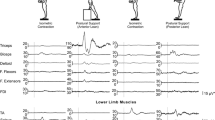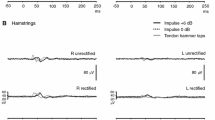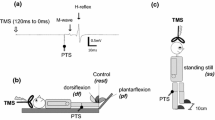Abstract
We studied the short-latency (SL) postural effects of axial impulses in 11 subjects (22 ± 2 years old). Recordings were made bilaterally from soleus and tibialis anterior (TA) muscles. We confirmed that with leaning anteriorly and posteriorly, reflex EMG increases occurred in both muscle groups at short latency following brief perturbations applied over C7 or the sternum (soleus mean latencies 57.5 and 66.4 ms; TA mean 51.7 and 55.4 ms, respectively). While the size of the SL reflexes was affected by the direction of lean when standing we found that light touch did not affect the amplitudes or latencies significantly. We investigated the presence of SL responses in the upper limb muscle triceps brachii during an isometric contraction and when the arm muscles had a direct role in supporting approximately 40% of the body weight. Similar levels of tonic EMG activity occurred in triceps in both conditions but significantly larger SL reflexes occurred when used posturally compared to the isometric contraction (23.0 vs 3.3%) while the reverse occurred for SL responses in soleus and TA, which were significantly attenuated. The responses were present with the head in the neutral position but with head rotation were larger contralateral to the direction of rotation. Calculations based upon the relative latencies suggest that the pathway responsible is not the corticospinal tract. We conclude that axially evoked SL postural reflexes are unaffected by light tactile input but are present in upper limb muscles when used for postural support. We propose that the pathway mediating these responses is the reticulospinal tract.



Similar content being viewed by others
References
Allum JHJ, Honegger F, Pfaltz CR (1989) The role of stretch and vestibulo-spinal reflexes in the generation of human equilibrating reactions. Prog Brain Res 80:399–409
Bloem B, Alum JHJ, Carpenter M, Verschuuren J, Honegger F (2002) Triggering of balance corrections and compensatory strategies in a patient with total leg proprioceptive loss. Exp Brain Res 142:91–107
Bőtzel K, Feise P, Kolev OI, Krafczyk S, Brandt T (2001) Postural reflexes evoked by tapping forehead and chest. Exp Brain Res 138:446–451
Britton TC, Day BL, Brown P, Rothwell JC, Thompson PD, Marsden CD (1993) Postural electromyographic responses in the arm and leg following galvanic vestibular stimulation in man. Exp Brain Res 94:143–151
Brown P, Day BL, Rothwell JC, Thompson PD, Marsden CD (1991) The effect of posture on the normal and pathological auditory startle reflex. J Neurol Neurosurg Psychiatry 54:892–897
Colebatch JG, Govender S, Dennis DL (2016) Postural responses to anterior and posterior perturbations applied to the upper trunk of standing human subjects. Exp Brain Res 234:141–149
Davis M, Gendelman DS, Tischler MD, Gendelman PM (1982) A primary acoustic startle circuit: lesion and stimulation studies. J Neurosci 2:791–805
Diener HC, Horak FB, Nashner LM (1988) Influence of stimulus parameters on human postural responses. J Neurophysiol 59:1888–1905
Fitzpatrick RC, Day BL (2004) Probing the human vestibular system with galvanic stimulation. J Appl Physiol 96:2301–2316
Fitzpatrick R, Burke D, Gandevia SC (1994) Task-dependent reflex responses and movement illusions evoked by galvanic vestibular stimulation in standing humans. J Physiol 478:363–372
Govender S, Colebatch JG (2017) Effects of midline sagittal location on bone-conducted cervical and ocular vestibular evoked myogenic potentials. J Appl Physiol. doi:10.1152/japplphysiol.01069.2016
Govender S, Dennis DL, Colebatch JG (2015) Axially evoked postural reflexes: influence of task. Exp Brain Res 233:215–228
Graus S, Govender S, Colebatch JG (2013) A postural reflex evoked by brief axial accelerations. Exp Brain Res 228:73–85
Gurfinkel VS, Lipshits MI, Mori S, Popov KE (1981) Stabilization of body position as the main task of postural regulation. Hum Physiol 7:155–165
Horak FB, Diener H-C, Nashner LM (1989) Influence of central set on human postural responses. J Neurophysiol 62:841–853
Horak FB, Shupert CL, Dietz V, Horstmann G (1994) Vestibular and somatosensory contributions to responses to head and body displacements in stance. Exp Brain Res 100:93–106
Laube R, Govender S, Colebatch JG (2012) Vestibular-dependent spinal reflexes evoked by brief lateral accelerations of the heads of standing subjects. J Appl Physiol 112:1906–1914
Marsden CD, Merton PA, Morton HB (1981) Human postural responses. Brain 104:513–534
Nashner LM, Wolfson P (1974) Influence of head position and proprioceptive cues on short latency postural reflexes evoked by galvanic stimulation of the human labyrinth. Brain Res 67:255–268
Nonnekes J, Van Geel K, Nijhuis LBO, Bloem BR, Geurts AC, Weerdesteyn V (2013) Loading enhances the occurrence of startle responses in leg muscles. Neuroscience 240:186–190
Ross SM (2007) Introduction to probability models, 9th edn. Academic Press, Amsterdam
Rossini PM, Beraradelli A, Deuschl G, Hallett M, de Noordhout AM, Paulus A, Pauri F (1999) Applications of magnetic cortical stimulation. Electroenceph Clin Neurophysiol Suppl 52:171–185
Rothwell JC (2006) The startle reflex, voluntary movement, and the reticulospinal tract. Clin Neurophysiol Suppl 58:223–231
Schepens B, Drew T (2006) Descending signals from the pontomedullary reticular formation are bilateral, asymmetric, and gated during reaching movements in the cat. J Neurophysiol 96:2229–2252
Stapley PJ, Drew T (2009) The pontoreticular formation contributes to the compensatory postural responses observed following removal of the support surface in the standing cat. J Neurophysiol 101:1334–1350
Watson SRD, Colebatch JG (1998) Vestibular-evoked electromyographic responses in soleus: a comparison between click and galvanic stimulation. Exp Brain Res 119:504–510
Welgampola MS, Colebatch JG (2001) Vestibulospinal reflexes: quantitative effects of sensory feedback and postural task. Exp Brain Res 139:345–353
Wilson VJ, Peterson BW, Brooks V (1981) Vestibulospinal and reticulospinal systems. In: Handbook of physiology, section 1, the nervous system, Vol. II Motor Control, vol 14, pp 667–702
Author information
Authors and Affiliations
Corresponding author
Ethics declarations
Conflict of interest
No conflicts of interest, financial or otherwise, are declared by the authors.
Rights and permissions
About this article
Cite this article
Teng, B., Govender, S. & Colebatch, J.G. Postural responses in the upper limbs evoked by axial impulses: a role for reticulospinal projections. Exp Brain Res 235, 2235–2242 (2017). https://doi.org/10.1007/s00221-017-4963-y
Received:
Accepted:
Published:
Issue Date:
DOI: https://doi.org/10.1007/s00221-017-4963-y




